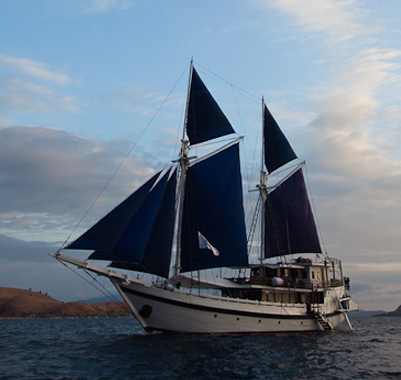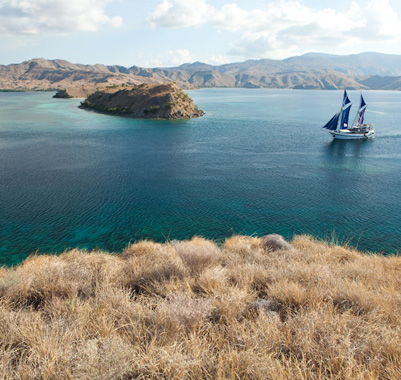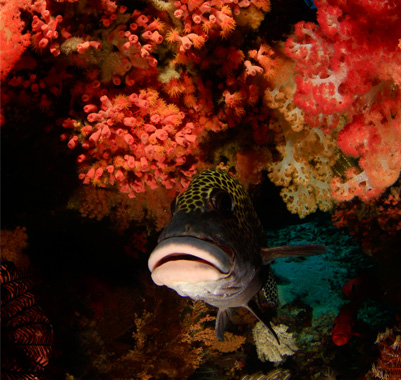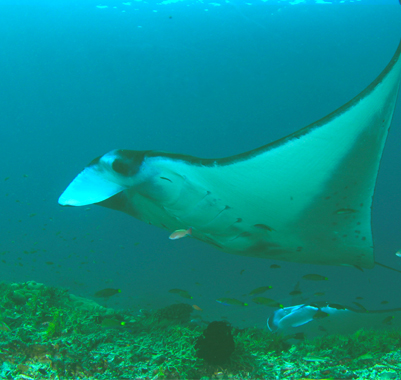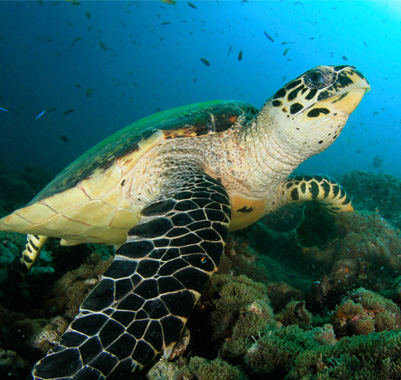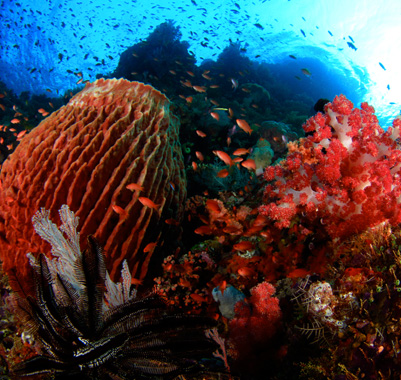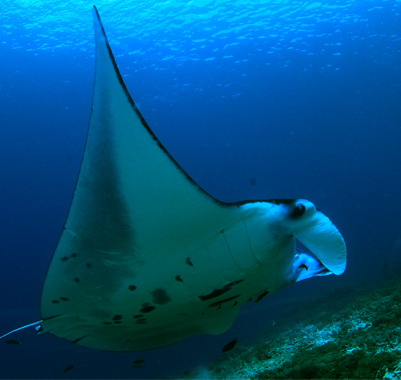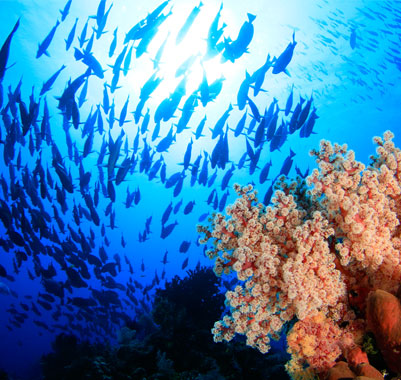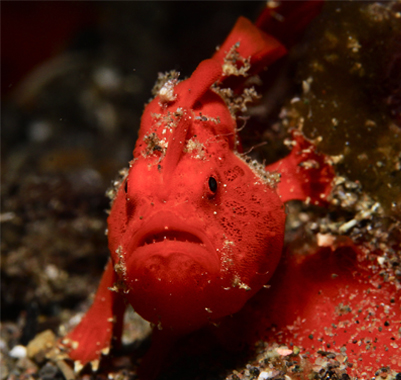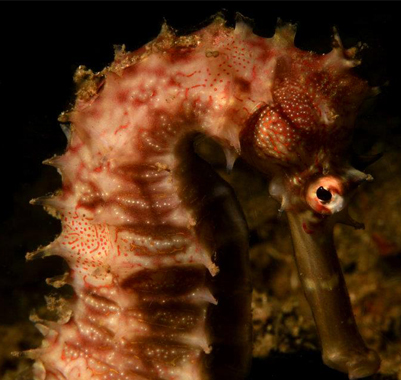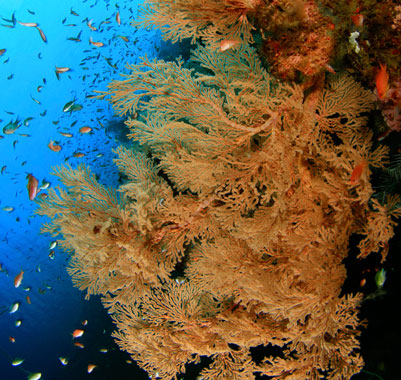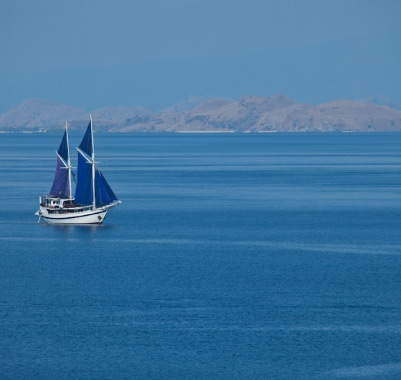Stretching over 500 kilometres of Nusa Tenggara from Bali to Flores, the Ombak Biru's area of operations is split into four distinct and different areas: Bali & Nusa Penida, Satonda & Moyo, Sangeang & Bima and the Komodo National Park.
Moving from west to east we sometimes start or finish cruises with sites on Bali and Nusa Penida with visits to the more famous dives; the shipwreck at Tulamben or hunting the giant Mola Mola in Nusa Penida being included in an itinerary.
The islands of Satonda and Moyo are at the mid-point to the north of Sumbawa and have interesting reefs, wrecks and walls to be explored.
The very different coral and critter sites at Sangeang Island, the twin peaked volcano are included as is another area that is gaining recognition, Bima Bay, where sand/muck diving is the order or the day. This body of water that leads to the harbour town of Bima on Sumbawa is shaping up to be a rival to the Lembeh Strait in Sulawesi.
Our main area of interest however is the Komodo National Park and that is where this document mainly concentrates with nearly 50 major dive sites and a lot more either undived or not visited regularly.
What follows is an itinerary for an 11 day cruise from Bali to the Komodo National Park stopping at some of the most famous and exhilarating dive sites in the region.
Day 1:
Arrival and boarding the Ombak Biru
Benoa Harbour, Bali
Welcome aboard the Ombak Biru. Lunch will be served shortly after boarding followed by vessel and diving orientation briefings. Dive equipment and camera systems can then be set up while the boat slowly makes its way north east across the Badung and Lombok Straits on our way to Moyo and Satonda.
Day 2:
Getting Started
Satonda, North Sumbawa
Located just a couple of kilometres off the north-west coast of Sumbawa, Satonda is an extinct volcano whose caldera was filled with water when the nearby Mt. Tambora erupted. It was the biggest explosion mankind has been able to measure up to present time.
The ridges of what was once Mt. Satonda are now covered in lush forests that support wildlife such as pigs and many Macaque monkeys. A highlight of a visit to Satonda is the sight of many thousands of fruit bats that commute at dusk from the island to feed on the mainland, returning before first light the next day.
The dives here consist of coral reefs and sea mounts with a good variety of critters to find too.
Day 3:
Critter Capers
Bima Inlet, Sumbawa
A day spent in the calm waters of the Bima Inlet. There are a variety of dives here from teeming coral reefs as well as prolific critter dives to search out some of the more bizarre marine creatures. Below is an excerpt taken from one of our recent press releases:
Most scuba divers already know about the stunning diversity, spectacular marine life and exciting dive and land adventures to be encountered in the Komodo National Park, Indonesia. What we are discovering now are some incredible critter, muck and sand sites that we visit to the west of the park.
Many of our guests are avid photographers who like nothing more than hunting out weird and wonderful critters on the reef, sand or silt. A lot of our divers have told us about the fascinating muck diving of the Lembeh Strait. Our dive masters already have experience of Lembeh so we set out to find our own macro mecca closer to home.
We have come up trumps at two locations to the west of the Komodo National Park - Sangeang, an island volcano to the north of East Sumbawa and Bima Bay, an inlet that meanders down to Bima town on Sumbawa. There are two specific sites in both of these areas that are producing a dazzling array of rare creepy crawlies on a regular basis - "Fuzzy Bottom" at the entrance to Bima Inlet and "Black Magic" on Sangeang. Both are similar in that they are slightly current swept, as is Lembeh, and while not entirely muck, they do share similar bottom compositions - fine to coarse sand.
"Fuzzy Bottom" near Bima Bay is a newer site. Looking fairly nondescript from the surface and not much better once you descend this place comes alive once you get to the bottom. Fairly shallow and gently sloping the sand here provides shelter and a hunting ground to some of the rarest cephalopods on the planet. Five of the "Octopus Holy Grails" are here. Of the long arm variety Mimic's, White V and Wonderpus are fairly common and Blue Rings and Veiny have been seen on a regular basis too.
Apart from our eight tentacle friends there are zebra crab and Coleman shrimp in fire urchins, thorny seahorses, various ghost pipefishes, frogfish and strange looking puffers and porcupine fish too. Night dives here are a trip - battling crabs and shrimp fight it out on the bottom while trying to avoid the attentions of the other hunters.
Day 4:
Dive on a Volcano
Sangeang Island, North Sumbawa
We wake up under the gaze of Sangeang Api, a huge twin peaked volcano thrusting out of the ocean and one of the most active volcanoes in the Lesser Sunda Islands. Two large volcanic cones, 1,949m/6500ft - high Doro Api and 1,795m/5980ft - high Doro Mantoi, are in the centre and on the eastern rim, respectively, of an older, largely obscured caldera. Aside from the stunning mountainous scenery it is possible to see some evidence of agricultural work on the flatter land close to shore. Wild horses and domestic buffalo can sometimes be seen on the beaches here too.
The underwater world of Sangeang is every bit as impressive as the island itself with caves, canyons and mysterious reefs bubbling like champagne due to the volcanic activity below. The island has some great black sand critter sites too to keep the photographers happy. Here is another paragraph from the same press-release mentioned above:
"Black Magic" is located on the northern tip of Sangeang, west of the lighthouse, and is marked out by two large rocks on the shore, left and right. The deeply shelving topography in this bay consists of black sand with coral reefs east and west, is relatively easy to dive and has produced seahorses, pygmy seahorses, Ambon scorpion fish, ghost pipefish, frogfish, inimicus, snake eels, stargazers, dragonets, sawblade shrimp, candy crabs and a whole host of rare nudibranches.
Day 5:
Little & Large
Gili Banta, The Sape Strait
The large and impressively desolate island of Gili Banta is situated in the Flores Sea at the top of the Sape Strait, the channel between the islands of Komodo and Sumbawa. When waking up here the dry rugged and rugged terrain of the impressive north facing cliffs comes as a bit of a shock for those used to more tropical landscapes.
There is little in the way of vegetation on Banta save for a few sparse trees and bushes growing above the beaches. Majestic sea eagles make their home on the towering rock faces that plunge down into the deep blue sea and can frequently be seen soaring and swooping while on the hunt for a meal.
The main diving sites are situated on the north facing bay, on and around what is almost certainly the caldera of a massive extinct volcano. There are two peninsulas to the east and west of the bay, both homes to spectacular sites; one a current swept promontory with breathtaking architecture, the other a picturesque coral reef.
Inside the bay itself, which stretches nearly five kilometers across, there are a couple of pretty white sand and coral head spots that often come up with unusual critters and are ideal for underwater photography and night dives.
The main attraction at Gili Banta however, is the much talked about GPS Point, probably the most unpredictable and demanding dive in the area, but so rewarding for those willing to face the challenge.
Komodo, The Land That Time Forgot
Komodo! Mention the word in company almost anywhere and you are likely to get the same reaction; hushed mutterings about a mythical, far away land dominated by barren sun scorched mountains and low lying primordial forests set on islands surrounded by dazzling coral reefs. The conversation would then follow that these islands are protected by the fierce currents of a treacherous deep blue sea and ruled over by the most awe inspiring predator on the planet!
And you know what? This description is about as close as it gets!
Welcome to Komodo, the "Land That Time Forgot".
The Komodo National Park
Established in 1980 as a World Heritage Site the Komodo National Park is located some 250 nautical miles east of Bali and 8 degrees below the equator, deep in the Indonesian archipelago between the islands of Sumbawa and Flores. Encompassing 1,817 square kilometers and comprising the three main islands, Komodo, Rinca and Padar as well as many other smaller islets and rocky sea mountains, the park is considered to be one of the most exciting natural world adventure destinations on the planet. Intrepid travelers here can experience one of the richest marine environments in the world; get up close and personal with the ferocious Komodo Dragons along with many other fascinating land and sea encounters and excursions.
Marine Komodo
The huge island nation of Indonesia is home to the world's most prolific marine ecosystem and the Komodo National Park is right at the epicenter of all with wild activity. Most world class diving sites are usually formed by either unusual volcanic formations of undersea rock or extensive deposits of coral limestone, washed over by nutrient rich marine currents. Fortunately during its evolution the Komodo region of Indonesia has been blessed with all of this! This spectacular seascape is comprised mainly of volcanic seamounts, pinnacles, walls and canyons as well as fringing reefs, coral gardens, mangrove bays and sandy slopes; creating an unmatched variety of very different and distinctive dive environments.
Between the sea mounts the vast coral reefs, often in shallow water, teem with unusual tropical reef animals. In fact, this area plays host to more than 1,100 different species of fish. With a careful eye, even the most jaded observer can discover hundreds of new species of brilliantly coloured marine life, plus an astounding array of invertebrates, some of which have never even been properly identified yet!
The list of critter species is huge and new and unusual creatures are being discovered here all of the time. For fans of bigger animals the dive sites with stronger currents play host to majestic mantas, sharks and many other larger pelagic species. Whales, dolphins and turtles have made the park a playground and even the rare dugong or sea cow can sometimes be spotted in the mangrove areas.
North & South
The range of dive sites and conditions in Komodo are legendary and the northern and southern sides of the park offer two distinct underwater environments. The Flores Sea is to the north and the Indian Ocean lies to the south and these two vast seas are connected by the Sape, Linta and Molo Straits.
Between the months of March and November the clear warm waters flowing from the Banda and Flores Seas wash over the pristine hard coral gardens and seamounts in the north while in the south, deep cold water current from the Indian Ocean collide with the continental shelf causing upwelling's that produce a vast plankton banquet for the marine life here. Between the months of December and February these water conditions are reversed with warm blue water lighting up the south while colder, greener conditions are evident on the northern sites. During a single day water temperatures can vary wildly between 30 to 18 degrees Celsius in just a short distance at some times of the year.
Fierce Currents
Komodo is justly famous for its high energy adrenaline pumping dives and the gusting currents that surge and swirl through the deep channels around the seamounts between Komodo, Padar and Rinca islands and are the key to the parks wonderful marine life. These immense water movements produce such a wild variety of conditions that there is something here for everybody. Great visibility, massive cliffs of black basalt, sheer walls and dazzling coral gardens all combine to house one of the most prolific and diverse undersea ecosystem on earth!
Topside Komodo
Topside, the landscape is dotted with islands and islets of every description, their volcanic bases have been carved by eons of ocean wear, but their crowns are distinctive and unique. While most of Indonesia is green and tropically lush, Komodo is much dryer featuring lofty rocky peaks, creature filled green forests and grassy slopes and meadows that give a savanna type feel to the landscape; the a perfect habitat for its most famous resident, the Komodo dragon, the largest lizard on earth!
Beaches
The beaches of Komodo are a dream, sandy with a background of rocks and hills and mostly deserted. Great for trekking and beach combing but not a good place for sunbathing however, you have to remember what else lives here. Looking at the sand on some of these beaches brings yet another surprise, it appears to be pink in colour, and it actually is! The vermillion organ pipe coral that thrive in Komodo does not lose its pigment when it dies, it just washes up on these beaches and gets crushed and ground up with the regular white sand and produces this remarkable candy floss colouration.
Wildlife
While the giant man eating monitor lizards living here are undoubtedly the stars of the show, the islands in the park also support an impressive array of native wildlife, both in the air and on the ground.
Effortlessly swirling high in the thermals close to shore breathtaking hunting displays by White Bellied Sea Eagles and Brahminy Kites are a show not to be missed. In the wooded areas the trees screech, chatter and hoot with Green Imperial Pigeons and Yellow Crested Cockatoos, and on the forest floor the Megapode bird, a close relative of the domestic chicken, can be seen digging and building their earth mound nests, and these a just some of the birds that make Komodo an ornithologists dream.
The two largest islands in the park, Komodo and Rinca, are home to many types of land based fauna too. Snakes are common, especially during the wetter months, and it is not unusual to come across a cobra, python or green tree viper during a cross country trek. Wild pigs or boar can often be seen rummaging around in the undergrowth or wallowing in a cool mud pool. Deer are plentiful while herds of goats are resident on some of the smaller islands like Gili Lawah Laut. The park also supports some huge water buffalo and many families of mischievous crab eating macaques although these two creatures are only found on Rinca.
But whatever or wherever they are, they are all just dinner for the main event!
Enter the Dragon
Imagine a 150kg, three metre long, armour clad monster with serrated ripping teeth set in immensely powerful jaws, four sets of razor sharp claws on the feet of each stocky leg. Add to this a wickedly whipping tail capable of knocking a full grown man to the ground and the ability to inject toxic saliva into its victims with each bite. This all sounds like something straight out of a horror movie, your worst nightmare, or so you may think. Living on the islands of Komodo and Rinca, and nowhere else in the world, this mythical creature is no bad dream; this is the awesome Komodo Dragon!
Many times during an expedition we get hair raising opportunities to get up close and personal with these animals while on treks on the islands - just make sure that you keep a close eye on the bushes, around the trees and even on the beach, this apex predator takes no prisoners.
Jurassic Park
So fasten your weight belts and let's begin our epic journey around one of the most diverse and unique areas of the natural world, to a land of dragons and dramatic landscapes, fierce currents and sparkling corals in seas teeming with more marine life than almost anywhere else on the planet, a real life "Jurassic Park" above and below the surface of the sea. Whether you are ripping along the top of a sea mount on an electrifying current dive, poking around in the shallows late in the day or visiting the islands on a topside adventure, Komodo is calling!
Day 6 & 7:
Sea Mounts & Dazzling Reef - Hill Walking & Drift Dives
Gili Lawah Laut & Gili Lawah Darat, North Komodo
Located on the northern edge of the Komodo National Park the Gili Lawah area comprises of two bays on north Komodo and two islands, Gili Lawah Laut and Gili Lawah Darat. The terrain here is rocky hilly savannah and the two islands support big herds of goats as well as the ubiquitous sea eagles and blackbirds. There are some very scenic hikes up onto the tops of the hills here and the climber is rewarded with stunning views of the surrounding islands and waterways, especially at sunrise and sunset.
The diving here is some of the very best in the area, if not the world. Spectacular sea mounts, glittering reefs, current swept channels all in a relatively small area make diving here a must on every visit. Recently on two of the sites we have watched hunting dolphins with an entourage of grey reef sharks and giant trevalli. On other sites here there are families of manta rays and we even saw a dugong/manatee on one dive late last year (2007).
Day 8:
Mysterious Forests & Cannibal Rock
Nusa Kode, South Rinca
Nusa Kode is the name of a small island that sits in the lower claw of the island of Rinca. Another name for this part of the Komodo National Park is Horseshoe Bay. The island of Nusa Kode creates a calm waterway, much like a very wide river that has two mouths to the open sea and sometimes on an early morning entry into this area the low cloud hangs on the hills creating a very spooky atmosphere.
There is very dramatic scenery with the high hills of southern Rinca towering over the water. Wildlife of all kinds can be seen on the small beaches, pigs, monkeys, deer, sea eagles etc. This is also a great spot to observe Komodo dragons marching up and down the beaches and rummaging in the forests surrounding the waterway. There are some fascinating, and sometimes hair raising, land excursions to be had here.
Diving here has been written about in magazines, books and journals all over the world. It is sometimes cold, it is sometimes difficult to see in the plankton blooms but what awaits the diver here is nothing short of incredible; vibrant rocky reefs, sheer walls and dramatic sea mounts pulsate with marine life. There is even a critter/sand dive to match anything in the area. One of the sites here, Cannibal Rock, was once described as being one of the top five on the planet.
Day 9:
Chasing Dragons & Dancing In The Dark
Loh Liang, Central Komodo
Loh Liang is the bay on Komodo island where the new ranger station is located. It is from the jetty here that we begin our land tours to see the Komodo Dragon and the other wildlife living on this fascinating island. The Dragons can be seen around the ranger station offices and the museum. On the longer treks it is possible to see more dragons, many deer, wild pig, snakes, insects and birds, particularly the noisy sulphur crested cockatoos.
There is a particular night dive at Loh Liang that is fast becoming a favourite - Pink Beach. A mixture of sand and rocky reef this dive is comes alive after dark with interesting marine life, including the impressive Spanish Dancer.
Day 10:
Islands In The Stream
Tatawa, The Linta Strait
Located in the middle of the Komodo National Park, the Tatawa area - sometimes called "Current City" - consists of a group of small islands, rocky outcrops and sea mounts that are constantly buffeted with the strong currents sweeping up and down the Linta Strait that separates Komodo from Rinca.
Topside the larger islands of Tatawa Besar, Siaba and Sebayor are rocky and grassy, great for hiking with some striking views of the park from their highest points. There is little wildlife but they do support a number of birds in the shape of sea eagles, cormorants, pelicans and ravens.
Current City is home to some of the most thrilling dives in Komodo. Spectacular coral reefs can be drifted over, sometimes at high speed, guided by friendly turtles. The sea mounts, when dived at the correct tide and sea states are among the very best in the world, teeming with some of the park's larger residents. The dramatic slopes, walls, pinnacles and caverns of these dives are covered with marine life and are a photographers dream in the normally great visibility.
There is even a manta cleaning station in very shallow water at the island of Mauan that provides thrilling close encounters with these gentle giants.
Day 11:
Disembarkation
Labuhan Bajo, West Flores
After a short cruise back to West Flores we will disembark at the pretty harbour town of Labuhan Bajo for the short ride to the airport and the flight back to Bali.
Please note: This itinerary is only an example and we may at times visit different areas than those shown in this document and we always operate with a keen eye on weather and sea conditions as well as marine life expectations.
Leaving Bali at 9 in the morning your first day is spent travelling and relaxing on board. The following day we dive the Moyo and Santonda area before moving on to the western outskirts of the Komodo National Park to dive at Bima, Sangeang and Gili Banta. The rest of the trip is spent entirely in northern, central and southern areas the park diving the best sites available. On the final morning guests depart at Labuhanbajo in Flores for the quick trip to the airport to fly back to Bali.
Day 1:
Arrival and boarding the Ombak Biru
Labuhanabajo Harbour, West Flores
Welcome aboard the Ombak Biru. Lunch will be served shortly after boarding followed by vessel and diving orientation briefings. Dive equipment and camera systems can then be set up while the boat slowly makes its way to Sebayor Island on the outskirts of the Komodo National Park. Time permitting we will start diving here with a check dive in a protected sandy bay flanked by coral reefs and mini walls.
Day 2:
Sea Mounts & Dazzling Reef - Hill Walking & Drift Dives
Gili Lawah Laut & Gili Lawah Darat, North Komodo
Located on the northern edge of the Komodo National Park the Gili Lawah area comprises of two bays on north Komodo and two islands, Gili Lawah Laut and Gili Lawah Darat. The terrain here is rocky hilly savannah and the two islands support big herds of goats as well as the ubiquitous sea eagles and blackbirds. There are some very scenic hikes up onto the tops of the hills here and the climber is rewarded with stunning views of the surrounding islands and waterways, especially at sunrise and sunset.
The diving here is some of the very best in the area, if not the world. Spectacular sea mounts, glittering reefs, current swept channels all in a relatively small area make diving here a must on every visit. Recently on two of the sites we have watched hunting dolphins with an entourage of grey reef sharks and giant travelley. On other sites here there are families of manta rays and even a rare dugong was spotted on one dive site in this area.
Day 3:
Dive on a Volcano
Sangeang Island, North Sumbawa
We wake up under the gaze of Sangeang Api, a huge twin peaked volcano thrusting out of the ocean and one of the most active volcanoes in the Lesser Sunda Islands. Two large volcanic cones, 1,949m/6500ft - high Doro Api and 1,795m/5980ft - high Doro Mantoi, are in the centre and on the eastern rim, respectively, of an older, largely obscured caldera. Aside from the stunning mountainous scenery it is possible to see some evidence of agricultural work on the flatter land close to shore. Wild horses and domestic buffalo can sometimes be seen on the beaches here too.
The underwater world of Sangeang is every bit as impressive as the island itself with caves, canyons and mysterious reefs bubbling like champagne due to the volcanic activity below. The island has some great black sand critter sites too to keep the photographers happy. Here is another paragraph from the same press-release mentioned above:
"Black Magic" is located on the northern tip of Sangeang, west of the lighthouse, and is marked out by two large rocks on the shore, left and right. The deeply shelving topography in this bay consists of black sand with coral reefs east and west, is relatively easy to dive and has produced seahorses, pygmy seahorses, Ambon scorpionfish, ghostpipefish, frogfish, inimicus, snake eels, stargazers, dragonets, sawblade shrimp, candy crabs and a whole host of rare nudibranchs.
Day 4:
Critter Capers
Bima Inlet, Sumbawa
A day spent in the calm waters of the Bima Inlet. There are a variety of dives here from teeming coral reefs as well as prolific critter dives to search out some of the more bizzare marine creatures. Below is an excerpt taken from one of our recent press releases:
Most scuba divers already know about the stunning diversity, spectacular marine life and exciting dive and land adventures to be encountered in the Komodo National Park, Indonesia. What we are discovering now are some incredible critter, muck and sand sites that we visit to the west of the park.
Many of our guests are avid photographers who like nothing more than hunting out weird and wonderful critters on the reef, sand or silt. A lot of our divers have told us about the fascinating muck diving of the Lembeh Strait. Our divemasters already have experience in Lembeh so we set out to find our own macro mecca closer to home and the Bima Inlet provided us with just what we needed.
"Fuzzy Bottom" is one of the sites that we found here. Looking fairly nondescript from the surface and not much better once you descend this place comes alive once you get to the bottom. Fairly shallow and gently sloping the sand here provides shelter and a hunting ground to some of the rarest cephalopods on the planet. Five of the "Octopus Holy Grails" are here. Of the long arm variety Mimic's, White V and Wonderpus are fairly common and Blue Rings and Veiny have been seen on a regular basis too.
Apart from our eight tentacled friends there are zebra crab and Coleman shrimp in fire urchins, thorny seahorses, various ghost pipefishes, frogfish and strange looking puffers and porcupine fish too. Night dives here are a trip - battling crabs and shrimp fight it out on the bottom while trying to avoid the attentions of the other hunters.
Day 5:
Little & Large
Gili Banta, The Sape Strait
The imposing and impressively desolate island of Gili Banta sits in the Flores Sea at the top of the Sape Strait, the current washed channel that separates the islands of Komodo and Sumbawa. When waking up here after a voyage from the west the rugged dry terrain and towering north facing cliffs come as a bit of a shock for those used to the lush tropical landscapes of the Indonesian islands they have just left.There is little in the way of vegetation on Banta save for a few sparse trees and bushes growing on the rocky slopes and ledges above the beaches. Majestic sea eagles have made their homes on the vertical rock faces that plunge into the deep blue sea and are frequently seen soaring, swooping and even fighting with each other while hunting for a meal.
Gili Banta's main dive sites are situated in and around this north facing bay close to the edges of what is almost certainly the caldera of a massive but long extinct volcano. There are two points on the east and west ends of the bay; one a picturesque and teeming coral reef underneath a rocky peninsula, Starwars, the other a current swept promontory with breathtaking marine architecture called Rollercoaster.
For divers wanting a more sedate time there are some pretty white sand and coral reef sites such as The Circus and K2. These two sites are inside the bay and regularly come up with unusual marine critters and are ideal for underwater photography and night dives in easy calm conditions.
The main attraction at Gili Banta however is the infamous GPS Point, a high voltage coral covered underwater mountain and one of the most unpredictable and demanding dives in the Komodo area; but so rewarding when dived in the right conditions at the right time.
Enter the Dragon
Imagine a 150kg, three metre long, armour clad monster with serrated ripping teeth set in immensely powerful jaws, four sets of razor sharp claws on the feet of each stocky leg. Add to this a wickedly whipping tail capable of knocking a full grown man to the ground and the ability to inject toxic saliva into its victims with each bite. This all sounds like something straight out of a horror movie, your worst nightmare, or so you may think. Living on the islands of Komodo and Rinca, and nowhere else in the world, this mythical creature is no bad dream; this is the awesome Komodo Dragon!
Many times during an expedition we get hair raising opportunities to get up close and personal with these animals while on treks on the islands - just make sure that you keep a close eye on the bushes, around the trees and even on the beach, this apex predator takes no prisoners.
Jurassic Park
So fasten your weightbelts and let's begin our epic journey around one of the most diverse and unique areas of the natural world, to a land of dragons and dramatic landscapes, fierce currents and sparkling corals in seas teeming with more marine life than almost anywhere else on the planet, a real life "Jurassic Park" above and below the surface of the sea. Whether you are ripping along the top of a sea mount on One of the park's friendly crows snatches yet another meal A Komodo Dragons sniffs the air with it's forked tongue an electrifying current dive, poking around in the shallows late in the day or visiting the islands on a topside adventure, Komodo is calling!
Day 6:
Islands in the Stream
Tatawa, The Linta Strait
Located in the middle of the Komodo National Park, the Tatawa area - sometimes called "Current City" - consists of a group of small islands, rocky outcrops and sea mounts that are constantly buffeted with the strong currents sweeping up and down the Linta Strait that separates Komodo from Rinca.
Topside the larger islands of Tatawa Besar, Siaba and Sebayor are rocky and grassy, great for hiking with some striking views of the park from their highest points. There is little wildlife but they do support a number of birds in the shape of sea eagles, cormorants, pelicans and ravens.
Current City is home to some of the most thrilling dives in Komodo. Spectacular coral reefs can be drifted over, sometimes at high speed, guided by friendly turtles. The sea mounts, when dived at the correct tide and sea states are among the very best in the world, teeming with some of the park's larger residents. The dramatic slopes, walls, pinnacles and caverns of these dives are covered with marine life and are a photographers dream in the normally great visibility.
There is even a manta cleaning station in very shallow water at the island of Mauan that provides thrilling close encounters with these gentle giants.
Day 7:
Mysterious Forests & Cannibal Rock
Nusa Kode, South Rinca
Nusa Kode is the name of a small island that sits in the lower claw of the island of Rinca. Another name for this part of the Komodo National Park is Horseshoe Bay. The island of Nusa Kode creates a calm waterway, much like a very wide river that has two mouths to the open sea and sometimes on an early morning entry into this area the low cloud hangs on the hills creating a very spooky atmosphere.
There is very dramatic scenery with the high hills of southern Rinca towering over the water. Wildlife of all kinds can be seen on the small beaches, pigs, monkeys, deer, sea eagles etc. This is also a great spot to observe Komodo dragons marching up and down the beaches and rummaging in the forests surrounding the waterway. There are some fascinating, and sometimes hair raising, land excursions to be had here.
Diving here has been written about in magazines, books and journals all over the world. It is sometimes cold, it is sometimes difficult to see in the plankton blooms but what awaits the diver here is nothing short of incredible; vibrant rocky reefs, sheer walls and dramatic sea mounts pulsate with marine life. There is even a critter/sand dive to match anything in the area. One of the sites here, Cannibal Rock, was once described as being one of the top five on the planet.
Day 8:
The Flying Circus
Langkoi, South Komodo
Situated across the extreme southern edge of Komodo Island and facing the open Indian Ocean is Langkoi Bay. This huge area has one large island inside it, Tala, and is dotted with smaller islets and rocks. Great ocean swells break on the palm fringed beaches and impressive sheer cliffs and many large boulders can be seen hanging here during a century's long journey to the sea. Looking along the cliff base it is also possible to spot several yet to be explored caves. The high cliffs surrounding the bay to the north but these are a haven for sea eagles, particularly on the outer rocks.
There are several stunning dives here with a list of marine life that would shame other parts of the world, however, the main attraction of Langkoi is the manta rays. Whether these majestic creatures are feeding in the current swept channels, cleaning themselves at their stations or just flapping around on the surface in the late afternoon sun, they are always one of the most exciting sights a diver can see in the ocean.
Day 9:
Critters, Seamounts & Pink Beaches
Padar, Between Komodo & Rinca
Padar Island is situated in the main channel running between Komodo and Rinca Islands connecting the Indian Ocean to the Java Sea. The Ombak Biru's mooring is inside a southern bay protected by another smaller island, Padar Kecil. Although no Komodo dragons live on Padar the island does support a lot of other wildlife, including: sea eagles, deers, goats and some gigantic spiders.
Padar's dive sites offer a lot of variety too. Choose between teeming seamounts, sheers wave blasted wall or serene and prolific critters dives.
A spectacular feature of a Padar land excursion is a short hike across a ridge to the islands west facing bay. This bay looks across the Linta Strait over to Komodo island. The sand here shares the same characteristics as the sand on Komodo's Pink Beach and is mixed with the crushed remains of bright red/purple organpipe coral. Because this coral does not lose its colour when it dies the particles mix with the sand to give the impression that the beach is ringed in pink. This becomes all the more of a stunning sight when the sun starts to set giving fantastic photo opportunities.
Day 10:
Chasing Dragons & Dancing in the Dark
Loh Liang, Central Komodo
Loh Liang is the bay on Komodo island where the new ranger station is located. It is from the jetty here that we begin our land tours to see the Komodo Dragon and the other wildlife living on this fascinating island. The Dragons can be seen around the ranger station offices and the museum. On the longer treks it is possible to see more dragons, many deer, wild pig, snakes, insects and birds, particularly the noisy sulphur crested cockatoos.
There is a particular night dive at Loh Liang that is fast becoming a favourite - Pink Beach. A mixture of sand and rocky reef this dive is comes alive after dark with interesting marine life, including the impressive Spanish Dancer.
Day 11:
Disembarkation
Labuhanbajo, West Flores
After a short cruise back to West Flores we will disembark at the pretty harbour town of Labuhanbajo for the short ride to the airport and the flight back to Bali.
Please note: This itinerary is only an example and we may at times visit different areas than those shown in this document and we always operate with a keen eye on weather and sea conditions as well as marine life expectations.
After a morning flight from Bali to Maumere in Flores you will board the Ombak Biru and immediately set off east for some diving the next day on northern Adonara and Lembata before carrying on into the Panta/Alorstrait to dive the norther, central and southern sites of the area. We return either around the northern or southern coasts of Pantar and end our trip diving some of the spectacular sites on northern Flores and Maumere bay. On the morning of departure you will be transferred to the airport for the flight back to Bali.
Day 1:
Arrival and boarding the Ombak Biru
Maumere Harbour, North Flores
Welcome aboard the Ombak Biru. Lunch will be served shortly after boarding followed by vessel and diving orientation briefings. Dive equipment and camera systems can then be set up while the boat slowly makes its way out of Maumere harbour and into the Flores Sea.
Day 2:
Getting Started
Maumere Bay, North Flores
The bay at Maumere hosts and impressive and diverse array of dive sites; muck, walls, reef and even a shipwreck are the high points here. It is a great starting or ending point for any cruise as the harbour at Maumere is close and it is easy to hit any of the sites from there. To the east of the harbour there are several sandy gravel critter dives but the main two sites are the muck at Wodong Bay and the shipwreck a little further along the coast. To the north there is a great reef drift at Pangabatang while at Babi the shallow reef extends well away from the island before dropping off to walls, ledges and cracks; a similar underwater topography is shared at Pulau Besar. Pomana Besar and Pomana Kecil have a couple of great dives too, again with shallow reef dropping to deep walls, all with spectacular coral growth, teeming marine life. Most of the sites in the bay are easy to dive too.
The islands in the bay and town of Maumere were hit by a huge earthquake and tsunami in December 1992 which destroyed what was reckoned to be one of the Indonesia's best diving areas and evidence of this dual disaster is still evident on the wall and reef but the corals and marine life have rebounded and are now nearing their former glory. Keep any eye out in the bay too, we have spotted a lot of whales surfacing for air here.
Day 3:
The Legends of Bacatan
The Bacatan Peninsula, Lembata
This area of the island of Lembata (Kawalu) is dominated by the imposing sight of Ill (Gunung) Ape (Fire Mountain) - 1,450 metres, the sometimes smoking and very active volcano and further west Gunung Ujulewon - 1,550 metres. There are many remote traditional villages dotted around the coastal perimiters of these mountains with the population specializing in fine Ikat weaving, fishing and animist beliefs.
The dive sites in this area offer great variety with dramatic sheer walls, sparkling reeftops, deep ledges, caverns and, on the slopes of Ille Ape, some tremendous black sand critter diving. On the ledges and walls it is common to see a variety of sharks, including black tips, white tips and greys; groups of eagle rays make frequent appearances too.
A new site that we have found at close to the village of Watu Wara Wutun has only been dived a few times so far but has already come up with a variety of sand dwelling octopus as well as a several different types of ghost pipefish, we have very high hopes for this site in the future.
Looking away from Lembata to the north on days with good visibility it is possible to see the island volcano of Komba. We visited here one morning (20 April 2009) with the idea to dive in a couple of areas. As we approached the island the smell of sulphur was in the air and the boat became covered in volcanic dust, it was possible to see molten lava and ash spewing from the east facing crater accompanied by deep rumbling sounds from within. A tender was dispatched to go close to the island but came back quickly - we thought better of diving here and moved away - impressive though the visit was.
The Alor/Pantar Strait
Located at the eastern tip of Nusa Tenggara, western the mythical and mysterious island of Alor has long been a mecca for the more adventurous diver. Difficult to get to it may be but the rewards are there for those who seek off the beaten track diving. Fierce currents sweep the strait between Pantar to the west and Alor itself, the islands of Pura, Ternate and Buaya acting as baffles in between, producing a divemasters nightmare for current predictions.
The end product of all the water movement here however is world class diving. Vertical walls, scintillating sea mounts and magnificent muck combine to produce a perfect environment tailor made for the marine life that live here, everything from Mola Mola to Harlequin Shrimp can be spotted. Add to this the friendly locals and the lack of other dive boats Alor is establishing itself as one of the hotbeds of Indonesian diving.
Day 4:
Pristine Reefs and Endless Visibility
Ternate, Alor/Pantar Strait
Ternate is a limestone island towering out of the northern end of the Alor/Pantar Strait. The interior of the island rises up to 800 metres and is surrounded with a fringing reef that plunges into the depths sometimes just a few metres from the shore.
Currents here can be a little confusing. Having driven all around the island in a tender during a strong ebb (southbound) tide we found several places where there were strong counter currents, moving north, particularly on the eastern side.
The fringing reef has very good coral cover and dense but small marine life. The predominant topography is sloping reef, walls, overhangs and caverns although the northern part of the island has extensive flat and shallow reefs with some sandy bays.
Day 5:
Critters and Anemone Carpets
Pura, Alor/Pantar Strait
Pura is the largest and most inhabited island in the Alor/Pantar Strait. Its mountainous interior rises to 1,050 metres and the landmass is 4 nautical miles across. There are a few villages here, each having their own place of worship, either mosques or churches. The main industry appears to be fishing as can be seen by the large number or fish traps scattered around the reefs here.
Due to its position the water temperatures at dives on Pura can vary considerably. Sometimes the southern sites are blasted with cold water from the south causing a lot of surprised looks on some faces, as well as some whispered oaths directed at the divemasters.
Due to its location the island is constantly buffeted by strong currents and care has to be taken with site selection with a firm eye on moon and tidal information. The northern sites are generally the calmest with the southern shore sometimes hit with cold water and heavy swell from the open sea to the south.
The reefs at Pura are in particularly good condition with little evidence of damage, probably because of the fishing methods the local people employ. During a dive it is not unusual to encounter spear fishermen as they go about their daily business - they are also happy to pose for photos too.
Day 6:
Daring to Dive The Dream and Muck Galore
Alor Kecil, Kalabahi Sound
Kalabahi Sound is the narrow body of water that leads up to the main town on Alor, Kalabahi. Both sides of the sound rise high from the waters edge up to hilly peaks. There is more habitation (and electricity) on the northern side and the whole area has a roadway close to the shore.
Plenty of boat traffic uses the sound, small local ferries connect to the outlying areas and islands and fishing boats make daily trips out into the main Pantar/Alor Strait. Kalabahi is also a main port for the Pertamina petroleum organization and the Pelni ferry line. The bustling town has a number of facilities, the most important being a hospital and several pharmacies.
There are some excellent muck/critter diving sites here, some well known to dive operators and others still to be discovered.
Day 7:
A New Critter Hunting Mecca
Beangabang Bay, Pantar
Nestling on the south eastern edge of the island of Pantar, Beang Bay forms a natural harbour, the two outer points stretching 800 metres across, north east to south west, surrounded by rolling hills and woodland. A small, primitive village is spread across the coast inside the bay, populated, it seems, mostly by children, who have a small school house sited back from the beach.
There is a hot spring that empties into the bay below the schoolhouse and the black sand and rocks at the waters edge can become very hot indeed, particularly at low tide! The sparsely wooded slopes around the bay provide great opportunities for treks up onto the hilltops for spectacular views out over the Savu Sea to Treweg Island at the bottom of the Pantar/Alor strait and in the distance, the rocky coast of West Timor to the south.
There are several terrific dive sites here, both inside and outside the bay. The three main sites inside the bay are: Hot Property, Ribbon Eel Run and The Lava Flow, comprising between them coral reefs and volcanic sand and gravel areas, great for critter spotting and on a par with the some of the best dives at the Lembeh Strait. Night diving here can be particularly dramatic with the sea floor coming alive with juveniles such as boxfish, scorpionfish and waspfishes. The octopus that inhabit the shallows become very active at night too.
The reefs on the outer edges of the bay are blessed with sparkling reefs, outcroppings and ledges again featuring a prolific array of marine life. The rocky layout and tubastraea corals growing on these sites are reminiscent of the more famous dives in the southern Komodo National Park.
Day 8:
Pristine Reefs and Fine Textiles
Ternate, Alor/Pantar Strait
Named for its shape, apparently it looks like a crocodile, this limestone island sits at the top of the Alor/Pantar Strait and there are some interesting dive sites here. To the west and the east are the two major dive sites and both of these feature great coral growth and spectacular deep walls. The north facing shore of the island features sandy bays separated by small rocky cliffs.
There is a small fishing village on the south facing shore of this pretty island which features a mosque and some settlement further up the hill.
A big feature of a visit to Buaya are the textiles on display and sale here. The local women will paddle out in their canoes and boats to sell good quality spectacular and colourful Ikat weaves - prices are from Rp.200,000.
Day 9:
A Real Sizzler
Lewoleba Bay, Lembata
Midway between eastern Flores and Alor lie the islands of Adonara and Lembata separated by the Boling Strait and both featuring high and active volcanoes. The main centre of commerce here is the town of Lewoleba that boasts a bustling market and busy inter island ferry terminal. We have pioneered a couple of dive sites on the northern coast of Adonara one of which has been a good hunting ground for Frogfish. The main attraction in the area however is a site called Sizzler on the shores of Lembata in Lebaleba Bay. This small area has all of the attributes of sites in the Lembeh Strait with no crowds and an enviable critter list.
Day 10:
A Sunken Reef and Mysterious Peninsula
Serbete & Gedong, North Flores
Gedong is the name given to a rocky outcropping on the north west side of Tangjung Bunga, North Flores. There is a good calm anchorage here on the western side surrounded by high forested cliffs and a rocky beach. The main dive sites are on the open sea side with wall, slopes and reef and feature some big fish too with sharks and mantas spotted on many dives. The wall on the north west side is sheer and covered in very colourful and abundant coral growth.
Serbete is a shallow reef and sandbar complex to the east of Tanjung Gedong. There is a small island here with a lighthouse that is surround by dangerously shallow reefs, seamounts and sandbars. The complex has great corals on the reeftop and some fantastic wall diving.
Day 11:
Disembarkation
Maumere, North Flores
Our guests generally disembark early in the morning today after breakfast for the short flight back to Bali. For guests wishing to stay on longer there are some simple but comfortable resorts in Maumere Bay and land excursions are available, the best of which is a visit to the three coloured lakes in the craters of Keli Mutu volcano.
Please note: This itinerary is only an example and we may at times visit different areas than those shown in this document and we always operate with a keen eye on weather and sea conditions as well as marine life expectations.
